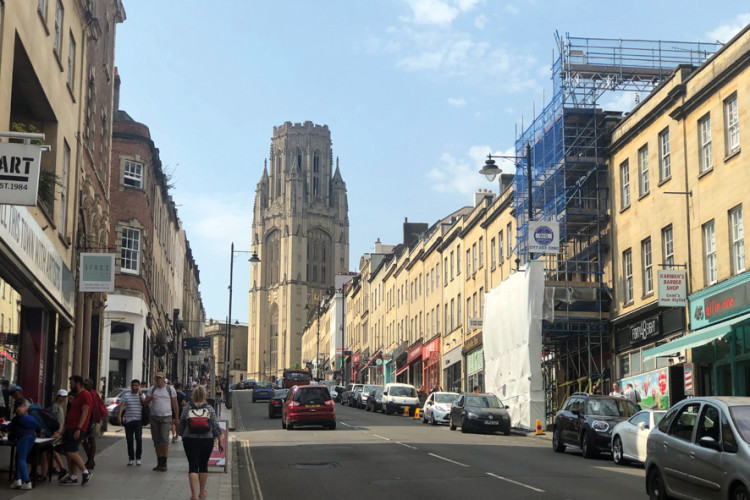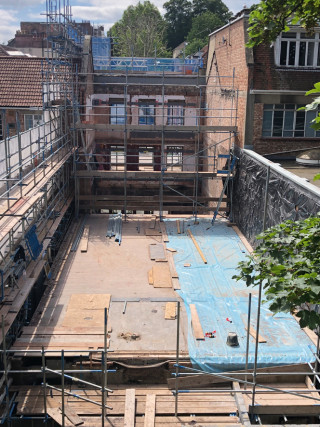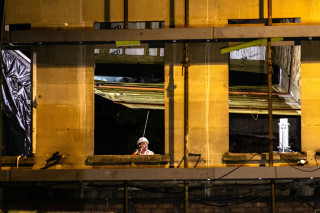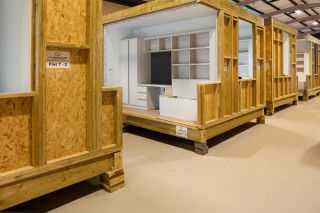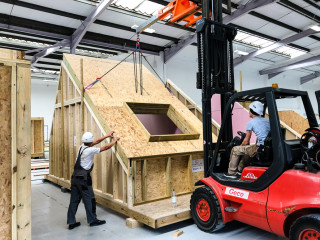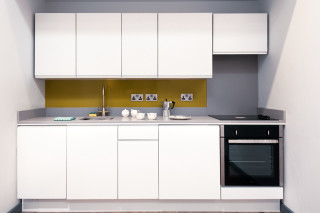There can hardly be a construction professional in the UK who doesn’t acknowledge the benefits of off-site construction. It drastically reduces on-site activity, requires less labour, reduces health & safety risk and delivers better quality standards thanks to the controlled factory environment.
Now one developer, Bristol-based Urban Creation, has taken the concept a stage further and slotted 17 factory-made, finished modular units into the shell of an existing building in Bristol city centre to create new student housing.
The site, at 50 Park Street, previously housed a nightclub but was vacant and in a dilapidated condition when Urban Creation bought it in 2018. While most of the buildings in Park Street are Georgian, 50 Park Street was built in the 1950s after the previous building was bombed during World War II.
Urban Creation had the building – a terraced property in one of Bristol’s busiest streets – gutted. All the internal walls and floors were ripped out and only the façade retained. Nine new student apartments comprising 17 custom-built volumetric units manufactured by Southampton-based off-site start-up, Go Modular, have now been installed inside the empty shell.
While modular construction has been used widely for new builds, Urban Creation director Jonathan Brecknell believes this is the first time in the UK that homes have been specially made to fit into the shell of an existing building.
“I don’t think it’s been done before – I certainly don’t know of any previous examples,” he says. “In fact, we think it might even be a European first; we had the French equivalent of the Financial Times over to do a story on us and they’d never encountered it before,” adds Brecknell.
Go Modular has created bespoke, ready-to-go homes built specially to fit into the building. This is an unusual approach, says Brecknell, as modular units are usually created in uniform shapes and sizes. The apartments were delivered fully fitted out and decorated with kitchens and bathrooms already in place.
The redevelopment of 50 Park Street was designed by local architectural practice Studio Henley (re-launched in March 2019 as Shu Architects following the death of practice principal Nick Henley). The new apartments occupy the top three storeys at the front of the building and two storeys at the back, with the ground floor being occupied by retail premises.
The units at the front of the building are supported by a steel grillage while those at the back sit on a beam-and-block floor. The tolerances for the off-site units are very tight; there’s only 50mm to play with in any direction, says Brecknell.
The original plan didn’t envisage modular construction; Urban Creation was expecting to carry out a traditional on-site redevelopment of the building. The off-site idea came out of the blue in the form of a speculative communication from the launch team at new off-site specialist Go Modular.
Brecknell knew the people behind Go Modular, having worked with them previously on timber-frame projects in Southampton and Bristol. “I’d worked with them on an off-site project with a complicated curved timber frame and it had fitted perfectly on-site,” says Brecknell. “Go Modular is the same management team, and that gave me confidence. So I sent them the drawings for this project to see what they could come up with.”
Go Modular’s bespoke service meant that the interior space of the apartments was not dictated by standard box dimensions. And, of course, the boxes could be designed so that the windows match perfectly with the existing opening in the building’s façade.
The limiting factor on box size and shape, however, was transport. “The design is constrained by what you can get on the lorry,” says Brecknell. “Our maximum box size was 5m by 14m by 4m. We were also constrained by access and how close we could get our crane,” he adds.
The original intention was to deliver the completed units and lift them sequentially into place over three nights, from Sunday 11th to Tuesday 13th August. Bristol City Council agreed to have Park Street closed to traffic between the hours of 8pm and 5am on these days.

But as it turned out, three nights was not nearly enough time. The operation had to continue on the Wednesday night and then again during the following Sunday and Monday nights – six nights in total.
“Bristol City Council were absolutely brilliant,” says Brecknell. “They couldn’t have been more helpful”.
The hold-up was caused by a combination of factors but the most significant was the challenge of lifting the boxes and lowering them into place within the narrow tolerances of the supporting frame.
Although the council allowed the road to stay closed until 6am, the crane had to be rigged and de-rigged every night, giving the team only a five- or six-hour window in which to work.
Installing the boxes was a much slower procedure than expected. Initially, the boxes were suspended from the crane hook on slings in the usual manner, but their asymmetrical dimensions and the variable distribution of weight inside them made it extremely difficult to level the boxes up and present them accurately.
“In the end we found that we had to use chain blocks on all four corners so that we could adjust them accurately,” explains Brecknell. “It was a very steep learning curve”.
The boxes were delivered with all services installed and then follows the task of connecting them up. Plumbing and drainage is all very straightforward, says Brecknell; the main drainage is being installed after the boxes.
More complicated is the power and telecoms. “There’s quite a lot of point-to-point cabling and there’s the door-entry system and the fire-alarm that goes on a loop around the buiding,” says Brecknell.
While no finishing is required inside the units themselves, there is some finishing at the interfaces between them and the original structure. Brecknell says he is hopeful that everything will be finished before the first occupants arrive at the beginning of term, later this month.
“We’re very excited to be taking modular construction to a new level, using a highly innovative approach that could have huge implications for home building in the UK,” says Brecknell.
Despite the time taken to install the units, Brecknell reckons that there is a potential 50% time saving on site-based activities using this bespoke off-site system. “It’s taken longer to complete than we had anticipated but this is the first time we’ve attempted it; we’ll be a lot slicker next time,” he says.
This article was first published in the September 2019 issue of The Construction Index magazine (magazine published online, 25th of each month.)
UK readers can have their own copy of the magazine, in real paper, posted through their letterbox each month by taking out an annual subscription for just £50 a year. Click for details.
Got a story? Email news@theconstructionindex.co.uk

